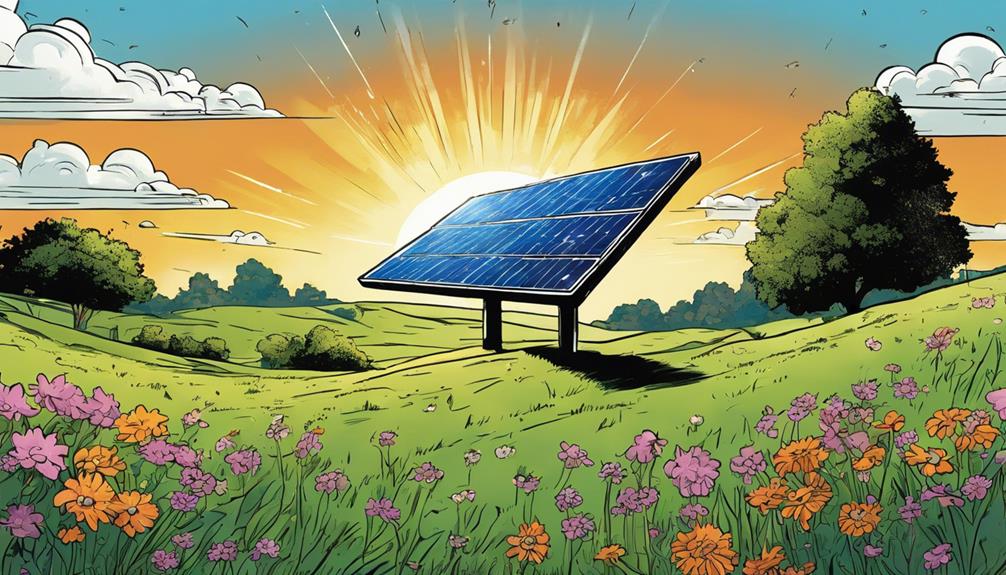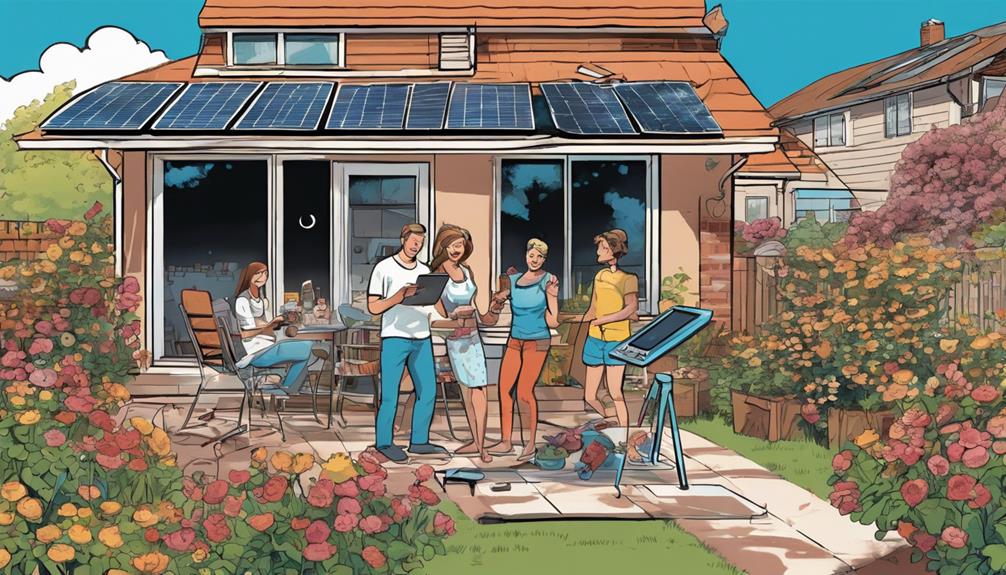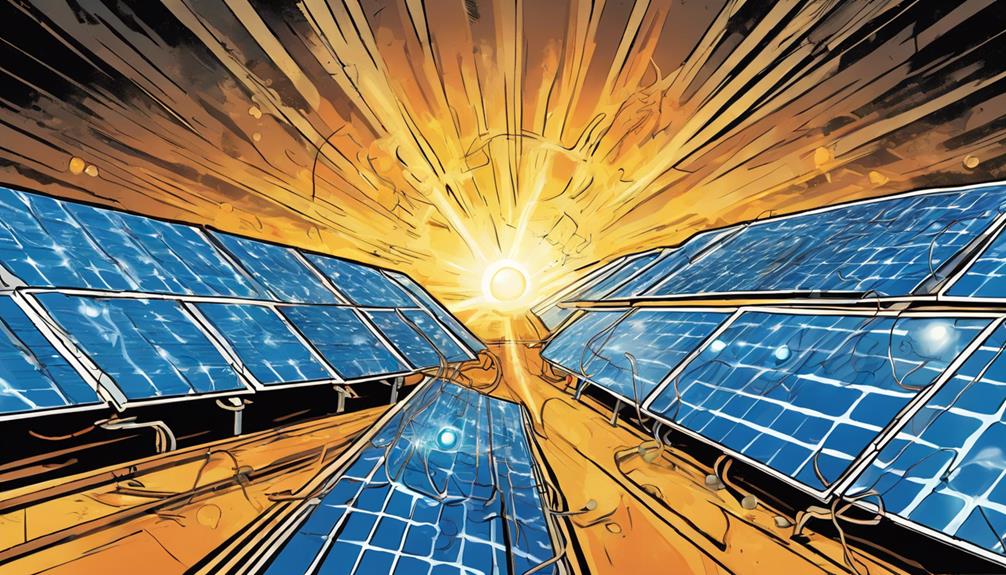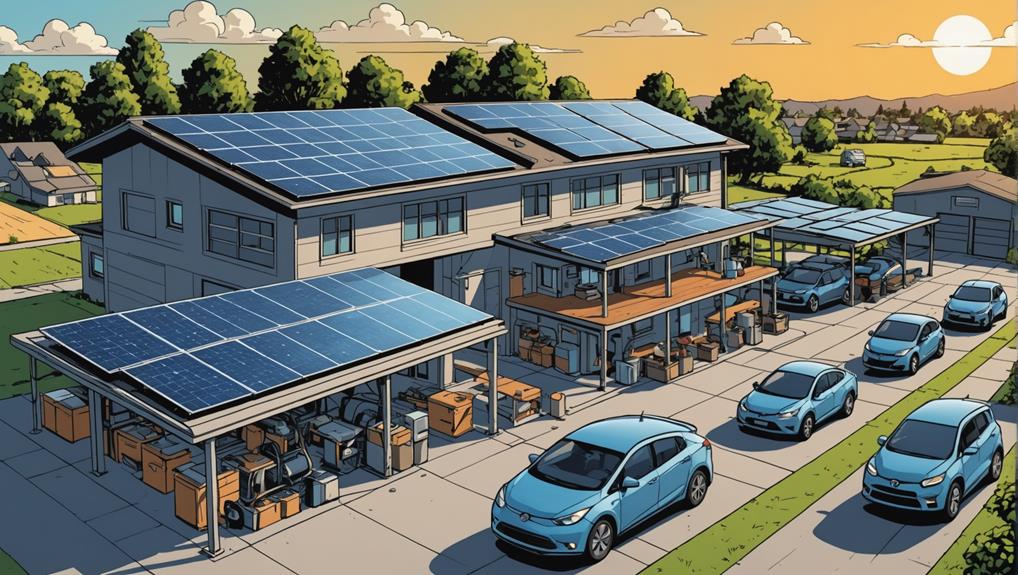When you leave a solar panel unconnected, the energy it generates doesn't vanish mysteriously – it's truly lost as heat within the panel itself. This occurs because sunlight prompts voltage buildup, resulting in heat production and module decline. If you don't attach a load or storage system, the energy will persist in dissipating, resulting in decreased efficiency, possible harm, and shortened lifespan. You're basically allowing valuable electricity go to waste. Want to learn how to capture that energy and optimize your solar panel's efficiency?
Key Takeaways
- Energy generated by an unconnected solar panel is wasted as heat within the panel, causing efficiency loss and potential damage.
- Without a load, voltage buildup occurs, leading to heat generation, module deterioration, and safety risks, including electrical shock and fires.
- Disconnected solar panels can cause overheating, reducing their lifespan and performance, and potentially leading to system failure.
- The energy produced cannot be utilized or harnessed, resulting in significant energy waste and inefficiencies in solar panel usage.
- If left unconnected, solar panels can become stuck in thermal equilibrium, dissipating energy as heat and failing to produce usable electricity.
Risks of Unconnected Solar Panels
If you leave a solar panel unattached, the generated energy will remain unused and dissipate as heat within the panel, putting it at risk of efficiency loss, potential damage, and reduced lifespan. This heat buildup can lead to overheating, which compromises the panel's performance and overall efficiency. Without an external circuit to utilize the energy, you're exposing the solar panel to risks that can greatly impact its functionality.
You're also vulnerable to voltage spikes, which can cause further damage to the panel's internal components. The longer you leave the solar panel unattached, the higher the likelihood of decreased efficiency and potential damage. It's crucial to connect your solar panel to a functional circuit to harness its full energy-generating potential. Disconnection can lead to a range of issues, from minor performance setbacks to complete system failure.
Technical Effects of Sunlight

As you examine the technical effects of sunlight on an unconnected solar panel, you'll notice that sunlight triggers three key consequences.
You'll see that voltage builds up without a load or circuit, heat generation accelerates degradation of the photovoltaic cells, and safety hazards arise from the energized panel.
These effects are critical to understanding the technical implications of unconnected solar panels.
Voltage Buildup
Frequently, when sunlight hits an unlinked solar panel, it triggers a voltage buildup that can reach potentially risky levels. As the solar panel generates electricity, the lack of a connected load leads to a buildup of voltage. This can cause safety risks, as unlinked modules remain energized, posing a threat of electrical shock.
| Effect of Unlinked Solar Panel | Outcome |
|---|---|
| Voltage Accumulation | Safety Risk, Electrical Shock |
| Lack of Load | Heat Generation, Module Deterioration |
| Prolonged Exposure to High Temperatures | Irreversible Performance Decline |
As you can observe, an unlinked solar panel can lead to serious problems. Without a load to utilize the energy, the solar panel may experience irreversible performance decline over time. Furthermore, the heat generated by the unlinked panel can worsen module deterioration, reducing the efficiency of the photovoltaic cells. To avoid these potential hazards and maintain peak performance, it is vital to ensure that your solar panel is connected to a load or circuit.
Heat Generation
When sunlight hits an unconnected solar panel, it converts the absorbed energy into heat, causing temperatures to rise within the panel. This heat energy is a direct result of the sunlight being absorbed without a load to utilize the generated power.
In a loaded panel, the energy production is utilized, and the excess energy is dissipated. However, without a load, the energy dissipates as heat within the panel, leading to heat buildup.
Continuous exposure to sunlight without a load connection can result in increased temperatures, accelerating the degradation of solar panel components. This heat buildup can reduce the panel's efficiency and overall lifespan.
As you can imagine, the panel voltage remains high, but the energy production is wasted as heat. It's crucial to connect your solar panel to a load or a storage system to prevent this heat generation and ensure efficient energy production. By doing so, you'll maximize the panel's efficiency and prolong its lifespan.
Safety Hazards
You're at risk of exposing yourself to safety hazards when you leave an unconnected solar panel in the sun, as the voltage buildup without a load or circuit can have devastating consequences. This voltage buildup can lead to energized modules, which pose a significant threat to your safety.
Prolonged exposure to sunlight can cause heat generation, exacerbating module degradation and efficiency reduction. The photovoltaic cells in the unconnected panels will degrade over time, reducing their overall performance and leading to permanent performance loss.
As the modules remain energized without a proper connection, you're at risk of electrical shock or even fires. It's essential to connect your solar panels to a load or circuit to guarantee safe energy generation. Neglecting to do so can result in serious safety hazards, including electrical accidents and property damage.
To avoid these risks, make sure to properly connect your solar panels and monitor their performance regularly. By doing so, you'll ensure a safe and efficient energy generation process.
Safe Disconnection and Storage
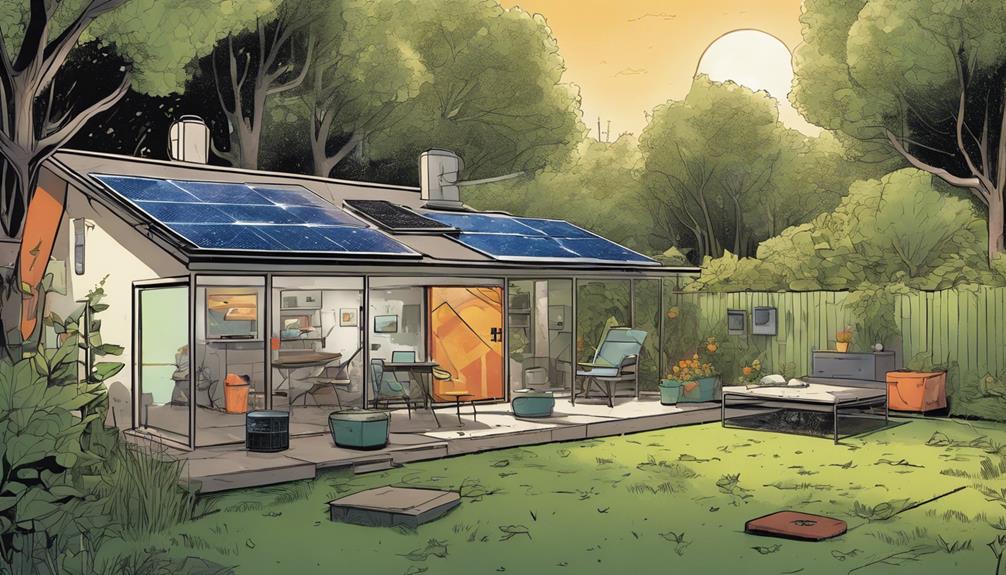
When you're disconnecting your solar panel, you'll need to take some precautions to guarantee your safety and the panel's integrity.
You'll want to properly disconnect and cool the system to prevent any accidental energy generation.
Disconnecting and Cooling
Before disconnecting your solar panel, it's important to switch off the inverter and isolate the DC power to stop electricity flow, guaranteeing a safe and controlled disconnection process. This step is crucial to prevent any accidents or electrical shocks.
Next, allow the solar panel to cool down before disconnecting the cables. This cooling period helps prevent overheating, which can damage the panel or cause injuries. When disconnecting, use insulated tools to avoid electric shock hazards.
Once disconnected, cover the solar panel with an opaque material to prevent energy generation, which can occur even when the panel isn't connected to a power system. Remember, safe storage practices are essential to maintain the longevity and efficiency of your solar panel.
Proper Storage Methods
To safeguard your disconnected solar panel remains safe and functional, store it in a shaded area or cover it with an opaque material to prevent direct sunlight exposure. This is essential in preventing overheating of the disconnected solar panel, which can occur when energy is converted into heat without a load.
When you disconnect your solar panel, make sure to follow proper storage methods to avoid energy wastage and potential damage to the system. Here are some key considerations:
- Switch off the inverters and isolators to prevent energy buildup and potential hazards
- Use a disconnect switch to safely isolate the panel from the rest of the system
- Avoid direct sunlight exposure to prevent energy dissipation as heat
- Store the panel in a well-ventilated area to prevent overheating
Maintenance for Idle Solar Panels

You need to regularly inspect your idle solar panels for physical damage or wear to make sure they remain in good condition and can function efficiently when you're prepared to connect them.
During inspection, look for signs of wear on the panels, mounts, and connectors. Cleaning is also important to maintain your idle solar panels' performance. Dust and debris can reduce their efficiency, so gently clean them with a soft brush or cloth.
To prevent prolonged sunlight exposure, consider shading solutions like canopies or umbrellas. When storing your idle solar panels, choose a dry, cool environment to prevent moisture damage.
Proper grounding is essential to prevent electrical hazards, so make sure your panels are securely grounded.
Energy Waste and Inefficiencies
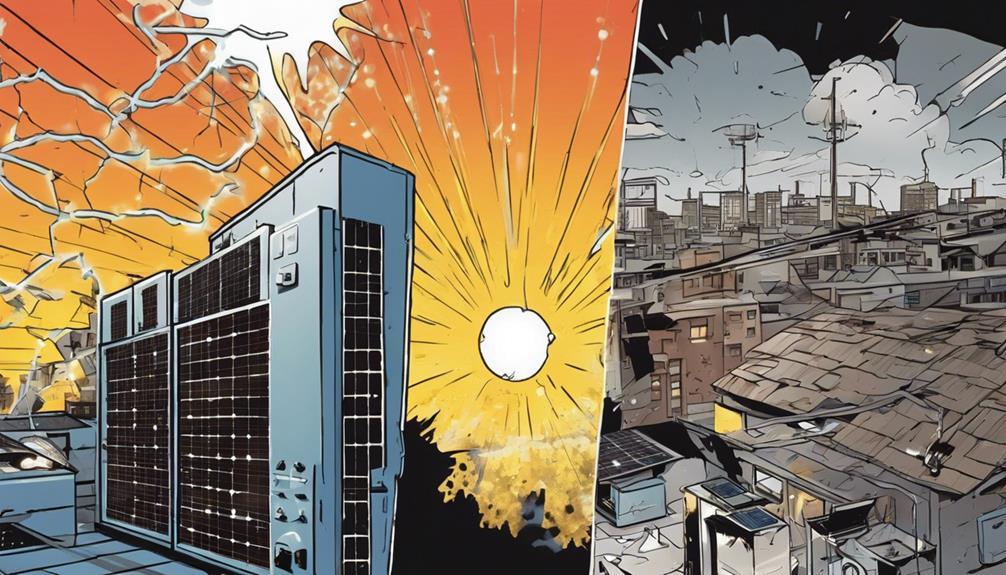
When an unconnected solar panel receives sunlight, it continues to generate electricity, but this energy goes to waste since it's not harnessed or stored for use. As a result, you're left with a significant amount of energy waste and inefficiencies. The generated energy is unused, leading to a wastage of potential electricity that could've powered your home or business. To avoid this energy waste, it’s important to have a system in place that can monitor and store the energy generated by unconnected solar panels. By implementing a monitoring system, you can track the amount of energy being produced and ensure that it’s being utilized efficiently. Additionally, it’s crucial to explore how to monitor solar energy in real-time to make adjustments and optimize usage for maximum benefit.
Here are some key consequences of this energy waste:
- The unconnected solar panel continues to receive sunlight and convert it into electricity that isn't utilized.
- The lack of connection results in energy accumulation within the panel without any productive output.
- Over time, the unconnected solar panel may experience degradation and reduced efficiency due to the unused energy buildup.
- This energy waste can lead to a decrease in the panel's overall performance and lifespan.
It's crucial to address this energy waste and inefficiencies to make sure you're getting the most out of your solar panel. By connecting your solar panel, you can harness the generated energy and put it to good use, reducing energy waste and maximizing your productive output.
Impact of No Load Connection
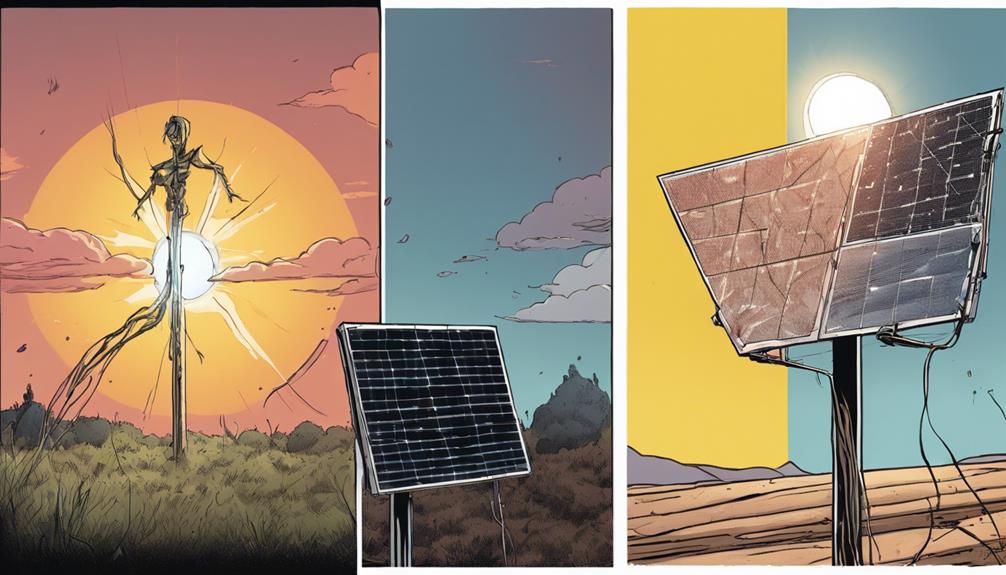
Without a load connection, the energy produced by your disconnected solar panel is trapped, incapable of being transformed into usable electrical power, and instead disperses as heat within the panel. This implies that the energy you're producing isn't serving any practical purpose – it's simply being wasted.
As a result, voltage buildup occurs within the panel, leading to potential hotspots and energy wastage. This is because the solar panel can't efficiently convert sunlight into usable electrical power without a load connection. The absence of a load hinders the movement of charge carriers, restricting the panel's energy conversion capabilities.
In essence, your disconnected solar panel is stuck in thermal equilibrium, where the produced energy converts into heat within the panel. This not only diminishes the panel's overall efficiency but also speeds up its deterioration.
It's crucial to connect your solar panel to a load to unleash its full potential and generate usable electrical power.
Solar Panel Characteristics

As you explore the world of solar panels, you'll discover that they exhibit unique features that greatly impact their performance and efficiency. Solar panels, comprising multiple silicon cells, are designed to generate energy from sunlight.
One essential aspect to keep in mind is the open circuit voltage, which typically ranges from 650-700 mV per junction in silicon diode solar panels. When you short-circuit the panel, the terminal voltage output drops to near zero.
On the other hand, solar cells typically produce maximum power at around 0.5 volts per cell, which is important to know when designing a solar panel system.
Here are some key characteristics to bear in mind:
- Peak power output is reached at approximately half a volt per silicon cell.
- When charging a 12V car battery, you'll need over 25 cells in series.
- Short-circuiting the panel leads to a near-zero terminal voltage output.
- The energy generated by an unconnected solar panel depends on these features.
Understanding these solar panel characteristics is crucial to harnessing the energy generated by an unconnected solar panel efficiently. By recognizing these traits, you can optimize your solar panel system's performance and maximize its energy output.
Practical Considerations for Solar Panels
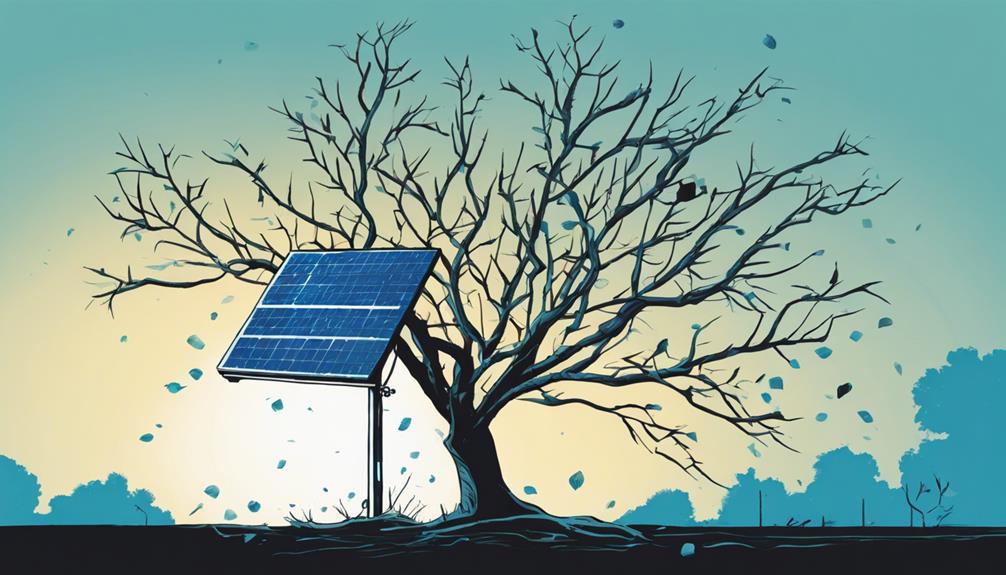
You'll find that solar panels require an external circuit to utilize their generated energy, meaning they don't produce electricity on their own. Without a load connected, the energy generated by the solar panel can't be utilized, and the charge carriers within the panel have nowhere to go. This leads to a state of thermal equilibrium, where the energy is dissipated as heat within the panel. As a result, the disconnected solar panel becomes hotter than a connected one, which can affect its performance and lifespan.
When it comes to practical considerations for solar panels, understanding the impact of load on energy conversion is crucial. Efficient power generation and peak performance rely on a proper load being connected to the panel. By ensuring a suitable load is connected, you can maximize energy utilization and minimize heat dissipation.
This knowledge is vital for installing and maintaining solar panels, as it directly affects their ability to generate power efficiently. By considering these practical aspects, you can get the most out of your solar panels and enjoy a reliable source of renewable energy.
Frequently Asked Questions
What Happens if Solar Panels Are Not Connected?
If you don't connect your solar panels, they'll just sit idle, generating energy that goes to waste, and potentially overheating due to lack of use, which can lead to inefficiencies and even damage over time.
What Happens to Disconnected Solar Panels?
"An idle mind is a devil's workshop" – and similarly, when you leave solar panels disconnected, they're prone to overheating, damage, and reduced lifespan, as the built-up energy goes to waste, compromising their efficiency and productivity.
What Happens to Unused Energy in a Solar Panel?
You're wondering what happens to unused energy in a solar panel. Well, it dissipates as heat within the panel, causing temperature increases and potential heat-related damage, leading to inefficiencies and reduced performance over time.
What Happens if You Disconnect Solar Panels Under Load?
When you disconnect solar panels under load, you risk voltage spikes, overheating, and system damage due to uncontrolled energy buildup, so it's essential you follow proper procedures to prevent these hazards and guarantee a safe shutdown.
Conclusion
When you leave a solar panel unconnected, it's like letting a wild horse run free – it's a waste of energy and potential. Without a load to channel its power, the panel can overheat, degrade, or even catch fire.
Don't let your investment go to waste; connect your solar panel to a compatible system, store the energy, or maintain it properly to make sure you're not burning daylight.
